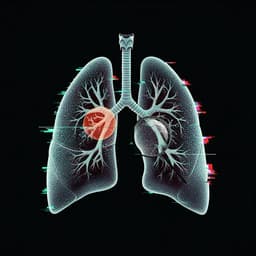
Space Sciences
The sound of a Martian dust devil
N. Murdoch, A. E. Stott, et al.
Experience the awe-inspiring sound of a Martian dust devil captured by the Perseverance rover's SuperCam, revealing insights into the planet's atmospheric dynamics. This groundbreaking research by N. Murdoch, A. E. Stott, M. Gillier, and their team showcases the power of acoustic data in understanding the Martian surface and wind-blown grain fluxes.
~3 min • Beginner • English
Introduction
Convective vortices and dust devils are common at the surface of Mars and abundant at Jezero crater, the landing site of the Perseverance rover. They form at the corners and edges of convection cells when warm air close to the surface rises and begins to rotate, generating a central pressure depression and strong rotational winds. These vortices are frequent during the Martian daytime and are a key element of the Planetary Boundary Layer, which mixes heat, momentum, dust, and chemical species. Understanding PBL dynamics is crucial for planetary meteorology. Convective vortices indicate atmospheric turbulence and act as important lifting mechanisms in the Martian dust cycle. Yet not all convective vortices lift dust, and site-to-site differences (e.g., Jezero versus InSight’s site) remain unexplained. The extent of observed dust lifting and sand motion on Mars exceeds expectations based on modeled and observed near-surface winds and laboratory results for motion thresholds under Mars-like conditions. A key missing measurement to test theories and improve models is the particle (grain) flux, which has not been directly measured on Mars. This study presents a direct encounter of a dust-laden vortex with Perseverance during which the SuperCam microphone recorded the sound of the dust devil, alongside simultaneous Navcam imaging and MEDA observations, to determine vortex parameters, trajectory, and grain-loading characteristics.
Literature Review
The paper situates dust devils within Martian boundary layer processes, noting their frequency and role in dust lifting. Prior work established pressure dips as the primary in-situ signature of vortices and documented ancillary signals (temperature, wind vector changes, magnetic signatures, infrasound, and ground tilt). The SuperCam microphone has been shown to correlate wind-induced acoustic power (20 Hz–1 kHz) with wind speed and to provide high-frequency measurements of atmospheric turbulence, while infrasound from vortices (<20 Hz) lies outside its band. Previous observations and models indicate that observed aeolian activity exceeds classical threshold expectations derived from theory, numerical modeling, and Mars-analog wind tunnel experiments; proposed mechanisms (e.g., electric field effects, transient low pressure) remain unverified in situ on Mars. Grain fluxes have only been inferred indirectly from evolving aeolian features; direct measurements are lacking. The study leverages multi-instrument datasets (MEDA, Navcam, RDS) and builds on heuristic and cyclostrophic vortex models to extract vortex properties and trajectories.
Methodology
- Instruments and data collection: The SuperCam microphone recorded atmospheric pressure fluctuations for 167 s at 25 kHz (bandwidth 20 Hz–12.5 kHz, highest gain 21 V/Pa). MEDA provided 1 Hz wind speed and direction (two booms at 1.5 m), barometric pressure (1 m), air temperature (ATS at 0.85–1.45 m), Thermal Infrared Sensor (TIRS) air temperature at ~40 m and ground temperature, and Radiation and Dust Sensor (RDS) lateral (LAT) and top (TOP) photometric channels. Navcam captured a Dust Devil Movie sequence.
- Microphone processing: Spectrograms were computed with 0.2 s windows. Low-frequency atmospheric signal was quantified via RMS in the 20–60 Hz band in 2 s windows. Pre-flight response corrections were applied below 100 Hz. Instrumental tones (e.g., ~760 Hz pump harmonic) and a ~6 kHz notch due to microphone base echo were identified to interpret acoustic origins.
- Event detection statistics: RDS analysis over the first 216 sols identified 91 dusty vortex encounters. Using cadence and detection rates, the probability that a single 167 s microphone recording between 11:00–16:00 LTST captures a similar event is 0.4–0.6%; Monte Carlo over 5062 s of joint mic–barometer data gives an 11–16% chance of at least one such event.
- Vortex identification and fitting: The barometer time series was fit to a standard vortex pressure profile to estimate core pressure drop and encounter duration. Cyclostrophic balance Vτ = (αΔP/ρ)^0.5 with α ≈ 0.52 (from Monte Carlo) and measured density (ρ ≈ 0.0149 kg/m³) provided peak rotational winds. Background wind (U) from MEDA (5.7 m s⁻¹ from 181°) was vectorially combined with vortex winds to obtain expected peak speeds and time series.
- Synthetic vortex data: Using ΔPobs(r) = ΔP/(1 + r²) and V = 2rVτ/(1 + r²), synthetic pressure, wind speed and direction, microphone RMS asymmetry, temperature responses, and RDS irradiance changes were generated for comparison with measurements. Background and vortex wind components were combined following established methodology.
- Monte Carlo parameter inference: Extensive parameter sweeps of translation speed, trajectory, core pressure drop, diameter, closest approach, and rotation sense were run to match multi-sensor time series (pressure, wind direction, microphone RMS) and constrain uncertainties (reported as standard deviations over the best four solutions).
- RDS photometry and geometry: LAT and TOP channel responses, including TOP-7 sun-direct-light blocking timing and TOP-8 duration in field of view, were used to estimate diameter (via trajectory–sun azimuth geometry) and minimum height from transit duration at the derived translation speed.
- Temperature analysis: ATS and TIRS temperature excursions coincident with the pressure minimum were examined, accounting for sensor placement and rover thermal influences.
- Navcam image analysis: Dust optical depth maps were derived by mean-frame subtraction and radiative transfer; dust cloud apparent size and motion were measured across frames to cross-check trajectory and size. Image-derived diameters carry >10% uncertainty per frame but were corroborated across multiple images.
- Grain impact detection: High-frequency (2–4 kHz) impulsive signals were extracted using an algorithm adapted from terrestrial acoustic grain-impact studies. Impact times were binned to obtain impact rates; acoustic features (e.g., 6 kHz notch) supported acoustic origin. Impact frequencies were converted to impacts per meter using the translation speed to estimate local grain number density.
- Context properties: Thermal inertia (425 ± 25 SI units) and albedo (0.14 ± 0.01) during sols 211–237 provided surface context during the encounter.
Key Findings
- A dust-laden convective vortex passed directly over Perseverance on 2021-09-27 (sol 215, Ls = 105°), producing a characteristic double-lobed low-frequency (20–60 Hz) microphone signal with a quiet period between peaks, coincident with a ~2.00 Pa pressure drop and sharp wind direction change.
- Derived vortex parameters (Table 1): diameter 25.0 ± 1.56 m; core pressure drop 1.97 ± 0.05 Pa; trajectory from 164.3 ± 1.4°; translation speed 5.3 ± 0.3 m s⁻¹; clockwise rotation; closest approach 0.17 ± 0.22 m (direct hit); height >118 m.
- Background wind 5.7 m s⁻¹ from 181°; cyclostrophic estimate with α ≈ 0.52 gives peak rotational winds ≈ 8 m s⁻¹; combined peak wind ≈ 11 m s⁻¹, consistent with MEDA max 10.7 m s⁻¹ and microphone-based ≈ 10.5 m s⁻¹.
- RDS photometry indicated low dust loading (irradiance changes 0.1–1%), placing the event in the lower third quartile of detected dust devils. Navcam-derived maximum dust optical depth τ ≈ 0.12.
- Temperature response: near-surface ATS showed ~2–3 K fluctuations comparable to background variability; clear TIRS peak of ~5 K at ~40 m altitude coincident with the vortex passage.
- Grain impacts: 308 individual impacts were identified in the audio, grouped into three bursts of 0.8 s, 1.2 s, and 1.4 s. Impact rates within bursts were 77, 144, and 78 impacts/s; mean over event ~60 impacts/s. Assuming 5.3 m s⁻¹ translation speed, maximum ~27 impacts per meter inferred, consistent with low dust content from RDS and imagery.
- A loud, broadband “bang” at 4.6 s after audio start (just after leading wall) showed a ~6 kHz notch due to microphone echo, supporting an acoustic origin and suggesting a particularly close and/or larger particle impact.
- Probability of detection: single 167 s mic recording between 11:00–16:00 LTST has ~0.4–0.6% chance to capture such an event; over 5062 s of joint mic–barometer data in the first mission year, Monte Carlo gives 11–16% chance of at least one similar encounter.
- Synthetic vortex models reproduced observed pressure dips, wind direction swings, and RMS asymmetry due to offset between background wind (Az 181°) and trajectory (Az 164°); some discrepancy with early wind-speed data likely due to MEDA sampling limits, highlighting the microphone’s advantage for rapid dynamics.
Discussion
The multisensorial dataset demonstrates that acoustic recordings provide high-temporal-resolution access to vortex wind structure, revealing the double-peaked signature of a direct-hit encounter and resolving rapid gusts beyond the temporal response of thermal anemometers. The detection and quantification of sand grain impacts via audio represent a new, direct proxy for aeolian particle motion on Mars, enabling estimation of grain number density and, with further calibration, potential mass flux. These observations inform the conditions under which saltation and dust lifting occur—key processes driving surface change and atmospheric dust loading, with implications for Martian climate variability and dust storm prediction. The results also underscore the complementarity of instruments: microphone acoustics, barometry, wind sensors, thermal measurements, radiometry, and imaging collectively constrain vortex geometry, dynamics, and dust loading. The unusual observation of a central dust cloud and a grain-impact burst near the vortex center suggests variability in dust distribution within vortices and motivates further study of dust lifting and transport within the vortex core versus walls. Acoustic data, with their high sampling rate and sensitivity to both wind-induced noise and impulsive grain impacts, open a new observational window to assess the fine-scale structure of Martian vortices and their aeolian transport efficacy.
Conclusion
This study reports the first recorded sound of a Martian dust devil and a unique, simultaneous multi-instrument observation of a direct rover overpass. The authors constrained the vortex’s size, trajectory, speed, pressure drop, and height; identified characteristic acoustic signatures of a direct-hit encounter; and, critically, detected and quantified individual grain impacts, demonstrating a direct method to probe wind-driven particle motion on Mars. These capabilities provide new avenues to quantify wind-blown grain fluxes, improving representations of dust lifting and transport in climate models and informing prediction of dust storms. Future work should include: laboratory calibration linking grain impact kinetic energy to microphone response to derive mass flux; characterization of acoustic attenuation and impact detectability versus distance; development of on-board data compression tailored to aeolian signals; and expanded recording campaigns during convective periods to build comparative statistics across vortices and sites for robust assessment of dust-lifting variability.
Limitations
- Frequency band limitation: the SuperCam microphone does not capture infrasound (<20 Hz), omitting part of the vortex acoustic spectrum.
- Impact localization uncertainty: the exact impact locations (microphone finger/tip or nearby structures) are unknown; signals may include structure-borne components.
- Wind sensor sampling: MEDA wind sensors operate at up to ~1–2 Hz, limiting resolution of rapid gusts and causing discrepancies with synthetic models during fast variations.
- Single-event and chance sampling: results are based on one direct-hit event with a low per-recording detection probability; generalization requires more encounters.
- Dust distribution ambiguity: Navcam images suggest atypical central dust concentration; interpretation of internal dust structure remains uncertain.
- Image-derived size uncertainties: individual frame diameter estimates are subjective with >10% uncertainty, though cross-checked across multiple frames.
- Acoustic attenuation: strong attenuation in the Martian atmosphere complicates detection range and inversion of impact energies without calibration.
- Mass flux not directly derived: converting impact counts to mass flux requires laboratory calibration of microphone response to grain kinetic energy and impact geometry.
Related Publications
Explore these studies to deepen your understanding of the subject.







